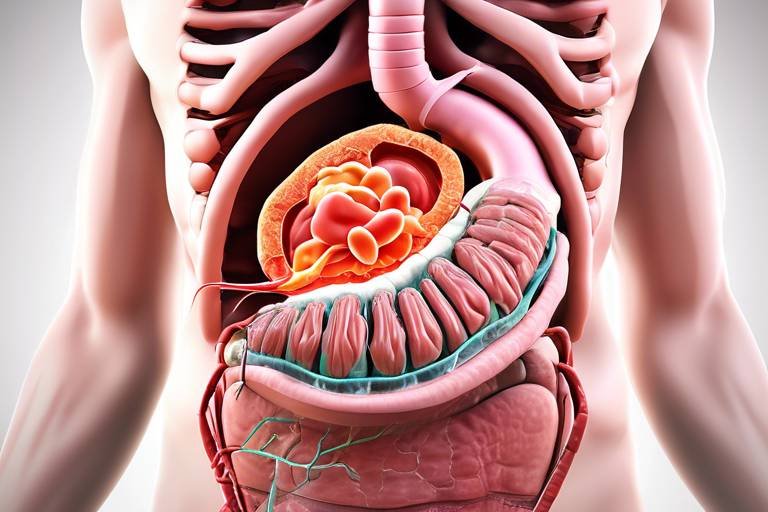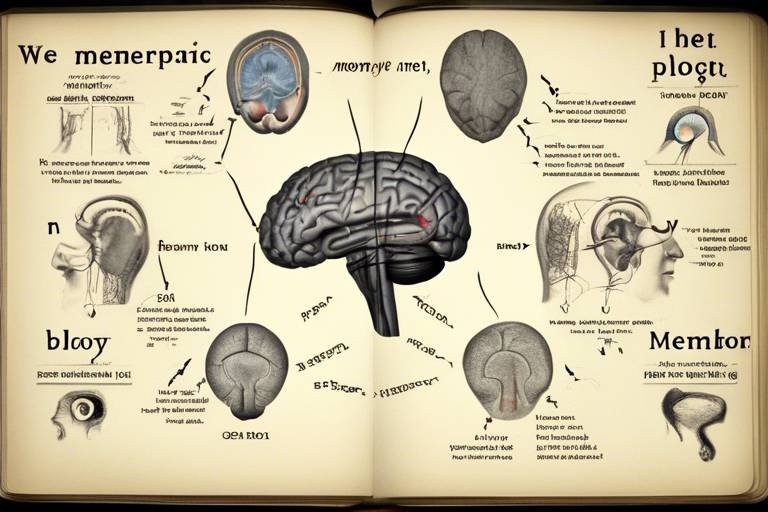The Biology of Aging - Cellular Changes Over Time
Aging is a complex and fascinating process that has intrigued scientists and researchers for centuries. It’s not just about the visible signs like wrinkles and gray hair; it’s about the intricate biological changes happening at the cellular level. As we age, our cells undergo various transformations that can significantly impact our health, longevity, and overall quality of life. Understanding these changes is crucial, as it opens the door to potential interventions that could enhance our aging experience. Imagine your body as a finely tuned machine; over time, wear and tear can lead to parts malfunctioning, and it’s the cellular changes that often dictate how well that machine continues to run. So, what exactly happens at the cellular level as we age? Let’s delve into the science behind it.
Cellular senescence is a term that describes a state where cells lose their ability to divide and function properly. Think of it as a stop sign for cells; they can no longer proceed with their regular duties. This phenomenon is significant because it contributes to aging and age-related diseases. When cells become senescent, they can accumulate in tissues, leading to inflammation and dysfunction. This accumulation can create a toxic environment in our bodies, much like a cluttered garage filled with old, broken items that hinder your ability to find what you need. The presence of these senescent cells can also disrupt the function of neighboring healthy cells, further accelerating the aging process. Understanding cellular senescence is crucial for developing strategies to combat its effects, potentially leading to healthier aging.
Now, let’s talk about telomeres. These are the protective caps at the ends of our chromosomes, much like the plastic tips on shoelaces that prevent them from fraying. With each cell division, telomeres shorten, and when they become too short, the cell can no longer divide. This shortening is a significant factor in the aging process and cellular lifespan. It’s as if our cells have a built-in clock that ticks down with every replication. When the clock runs out, the cell enters senescence or even dies. This process is a natural part of aging, but researchers are exploring ways to potentially extend telomeres and, in turn, cellular lifespan.
Enter telomerase, an enzyme that can extend telomeres and potentially reverse some effects of aging. Think of telomerase as a magical repairman who can fix the frayed ends of your shoelaces, allowing them to function properly again. Understanding its function may lead to breakthroughs in age-related therapies. However, while telomerase has therapeutic potential, it’s essential to approach it with caution.
Why the caution, you ask? Well, the activation of telomerase can also lead to uncontrolled cell growth, contributing to cancer. It’s a delicate balancing act; while we want to harness the power of telomerase for healthy aging, we must be mindful of its potential to promote malignancies. This duality makes telomerase a hot topic in aging research, as scientists strive to find ways to utilize its benefits without triggering adverse effects.
Ongoing studies are investigating how telomerase manipulation could promote healthier aging without increasing cancer risk. The goal is to unlock the secrets of this enzyme and find safe applications that could revolutionize the way we approach aging. Imagine being able to slow down the aging clock just a bit, giving us more time to enjoy life without the burdens of age-related diseases!
Another critical player in the aging game is oxidative stress. This condition arises from an imbalance between free radicals and antioxidants in the body. Free radicals are unstable molecules that can damage cells, leading to a range of issues from inflammation to accelerated aging. It’s like having a leaky faucet in your home; if left unattended, it can cause significant damage over time. Antioxidants, on the other hand, are our body’s repair crew, working to neutralize these harmful free radicals. A diet rich in antioxidants can help combat oxidative stress and promote healthier cellular aging.
Mitochondria, often referred to as the powerhouses of the cell, play a crucial role in energy production. However, as we age, mitochondrial function declines, leading to decreased energy production and increased oxidative stress. This dysfunction is linked to various age-related diseases, including neurodegenerative disorders like Alzheimer’s and Parkinson’s. Understanding this relationship is vital for developing targeted interventions that can help mitigate the effects of aging.
As we age, the decline in mitochondrial function can contribute to a host of health issues. It’s like a car running on low fuel; eventually, it’s not going to perform well. By addressing mitochondrial health, we may be able to improve not just longevity but also the quality of life in our later years.
So, how can we enhance mitochondrial function? Lifestyle changes play a significant role. Regular exercise, a balanced diet rich in nutrients, and adequate sleep can all contribute to better mitochondrial health. Think of it as tuning up your car to ensure it runs smoothly for years to come. By adopting these strategies, we can potentially mitigate some of the effects of aging and promote healthier cellular aging.
- What is cellular senescence? - Cellular senescence is the process where cells lose their ability to divide and function, contributing to aging and age-related diseases.
- How do telomeres affect aging? - Telomeres shorten with each cell division, and when they become too short, cells can no longer divide, leading to aging.
- What role does oxidative stress play in aging? - Oxidative stress results from an imbalance between free radicals and antioxidants, contributing to cellular damage and aging.
- Can lifestyle changes improve mitochondrial health? - Yes, regular exercise and a balanced diet can enhance mitochondrial function and promote healthier aging.

Cellular Senescence
Cellular senescence is a fascinating yet complex process that marks a significant turning point in the life cycle of our cells. Imagine a factory where workers gradually lose their ability to perform tasks efficiently; that's what happens to our cells as they age. They stop dividing and lose their functionality, essentially becoming inactive and contributing to a decline in overall health. This phenomenon is not just a natural part of aging, but it also plays a pivotal role in various age-related diseases, including cancer, diabetes, and cardiovascular conditions.
So, what exactly triggers this process? Cellular senescence can be induced by several factors, including:
- Telomere shortening: Each time a cell divides, the protective caps at the ends of chromosomes, known as telomeres, shorten. Once they reach a critically short length, the cell can no longer divide.
- Oxidative stress: An imbalance between free radicals and antioxidants can lead to cellular damage, pushing cells into a state of senescence.
- DNA damage: Accumulation of DNA damage over time, whether from environmental factors or normal metabolic processes, can trigger senescence.
Interestingly, while senescent cells are often seen as detrimental, they can also play a protective role. For example, they can prevent the proliferation of damaged cells, which could potentially lead to cancer. However, the accumulation of these non-dividing cells can create a pro-inflammatory environment, further contributing to age-related diseases. This paradox is what makes cellular senescence a double-edged sword in the aging process.
Moreover, researchers are exploring ways to target senescent cells therapeutically. The idea is to selectively eliminate these cells from the body, potentially rejuvenating tissues and improving health span. Preliminary studies have shown promising results, suggesting that clearing senescent cells can improve physical function and extend lifespan in animal models. However, the challenge lies in ensuring that we do not inadvertently promote the growth of cancerous cells in the process.
In conclusion, cellular senescence is a critical player in the aging game. It’s like a ticking clock that signals the end of a cell's productive life, with implications that ripple throughout our bodies. Understanding this process could unlock new strategies for enhancing health and longevity, allowing us to live not just longer, but healthier lives.
- What is cellular senescence? Cellular senescence is the process by which cells lose their ability to divide and function, contributing to aging and age-related diseases.
- What causes cellular senescence? Factors such as telomere shortening, oxidative stress, and DNA damage can trigger cellular senescence.
- Can cellular senescence be reversed? While complete reversal is challenging, research is underway to find ways to eliminate or rejuvenate senescent cells.
- How does cellular senescence affect health? The accumulation of senescent cells can lead to chronic inflammation and contribute to various age-related diseases.

Telomere Shortening
As we journey through life, our cells are constantly dividing to keep our bodies functioning optimally. However, there's a ticking clock within each of our cells, and it's called telomeres. These tiny structures act like protective caps at the ends of our chromosomes, ensuring that our genetic material remains intact during cell division. But here's the catch: every time a cell divides, these telomeres get a little shorter. Imagine them as the plastic tips on shoelaces; once they wear away, the laces start to fray, leading to potential issues. This gradual shortening of telomeres is a crucial factor in the aging process, and it has profound implications for our health and longevity.
Telomere shortening is not just a biological curiosity; it is intricately linked to various age-related diseases. As telomeres become critically short, cells enter a state known as cellular senescence, where they lose their ability to divide and function properly. This state can trigger inflammation and contribute to the development of chronic diseases, such as heart disease, diabetes, and even cancer. It's as if the body's repair mechanisms start to falter, leading to a cascade of health issues that can significantly impact our quality of life.
To understand the implications of telomere shortening, consider this: a study published in the journal Nature highlighted that individuals with shorter telomeres are at a higher risk of developing age-related conditions. The research suggests that telomere length could serve as a biomarker for biological aging, offering a glimpse into our overall health status. This link between telomere length and health outcomes has sparked interest in finding ways to maintain or even extend telomeres as a potential strategy for promoting longevity.
Interestingly, the rate of telomere shortening can be influenced by various lifestyle factors. Stress, poor diet, and lack of exercise can accelerate this process, while healthy habits like regular physical activity, a balanced diet rich in antioxidants, and effective stress management can help preserve telomere length. Think of it like a garden: if you nurture it with care, it flourishes, but neglect it, and it quickly deteriorates. By adopting healthy lifestyle choices, we may be able to slow down telomere shortening and, in turn, enhance our overall health.
In summary, telomere shortening is a fundamental aspect of aging that affects cellular function and overall health. Understanding this process not only sheds light on the aging phenomenon but also opens the door to potential interventions that could promote healthier aging. As research continues to uncover the intricacies of telomeres, we may find ourselves equipped with the tools to combat the effects of aging and improve our quality of life.

The Role of Telomerase
Telomerase is a remarkable enzyme that plays a pivotal role in maintaining the integrity of our chromosomes. Imagine telomeres as the protective caps on shoelaces; without them, the shoelaces (or chromosomes, in this case) would fray and become unusable. As we age, our cells divide, and with each division, these telomeres shorten, leading to cellular senescence or death. This is where telomerase comes into play, as it has the ability to extend these telomeres, potentially allowing cells to divide longer and healthier. The concept of telomerase is not just an exciting biological curiosity; it holds profound implications for our understanding of aging and longevity.
Research has shown that in certain cells, such as stem cells and germ cells, telomerase is highly active, which allows these cells to maintain their regenerative capabilities over time. However, the situation becomes a double-edged sword when we consider its activation in somatic cells. While extending telomeres could theoretically reverse some aging effects, it also raises concerns about the risk of cancer. When telomerase is activated inappropriately, it can lead to uncontrolled cell proliferation, a hallmark of cancerous growth. Thus, the challenge lies in harnessing the benefits of telomerase without triggering its potential dangers.
To better understand the balance between the beneficial and harmful effects of telomerase, researchers are conducting extensive studies. These investigations aim to uncover how telomerase can be manipulated to promote healthier aging while minimizing the risk of cancer. For instance, some studies are exploring telomerase activators that could potentially enhance its activity in a controlled manner, thereby providing the benefits of extended cellular lifespan without the associated risks.
As we delve deeper into the biology of telomerase, it becomes clear that this enzyme is not just a simple player in the aging process; it’s a complex actor in a much larger drama. The implications of telomerase research could revolutionize how we approach aging, potentially leading to therapies that could enhance our longevity and quality of life. The journey to understanding telomerase is still unfolding, and the excitement surrounding its potential is palpable.
- What is telomerase?
Telomerase is an enzyme that helps maintain the length of telomeres, which protect chromosome ends during cell division. - Why is telomerase important for aging?
Telomerase can extend the lifespan of cells by preventing telomere shortening, which is associated with aging and cellular senescence. - Can telomerase be used in cancer treatment?
While telomerase has potential therapeutic applications, its activation can also lead to cancer, making its use a delicate balance. - Are there any lifestyle changes that can affect telomerase activity?
Some studies suggest that lifestyle factors such as diet, exercise, and stress management may influence telomerase activity positively.

Telomerase and Cancer
Telomerase is a fascinating enzyme that plays a dual role in the biology of aging and cancer. On one hand, it holds the potential to extend the lifespan of cells by adding repetitive nucleotide sequences to the ends of telomeres, which are the protective caps on chromosomes. This process can theoretically delay cellular aging and promote longevity. However, this very same mechanism that can be beneficial in healthy cells can also become a double-edged sword. When telomerase is activated inappropriately, it can lead to uncontrolled cell proliferation, a hallmark of cancer. This paradox raises critical questions about how we might harness the power of telomerase without triggering malignancies.
In essence, the relationship between telomerase and cancer can be summarized as follows:
| Aspect | Telomerase Function | Cancer Implication |
|---|---|---|
| Cellular Aging | Extends telomeres, delaying senescence | Potential for unlimited cell division |
| Tumor Suppression | Can maintain normal cell function | May lead to tumorigenesis if overactive |
| Therapeutic Potential | Possible anti-aging treatments | Risk of cancer development |
Researchers are actively exploring ways to manipulate telomerase activity. The goal is to find a balance where the enzyme can be used therapeutically to combat age-related decline without risking the onset of cancer. Some studies suggest that targeted therapies could selectively activate telomerase in healthy cells while keeping it inactive in cancerous cells. This approach could potentially allow us to reap the benefits of telomerase without the associated risks.
Furthermore, understanding the mechanisms that regulate telomerase expression is crucial. For instance, certain proteins and signaling pathways are known to influence telomerase activity. By unraveling these complex interactions, scientists hope to develop strategies that could safely leverage telomerase for therapeutic purposes.
In conclusion, while telomerase holds promise in the quest for longevity and healthier aging, its connection to cancer underscores the need for careful research and consideration. Striking the right balance is essential to ensure that any advancements in telomerase therapy do not inadvertently lead to an increase in cancer risk.
- What is telomerase? Telomerase is an enzyme that adds nucleotide sequences to the ends of chromosomes, known as telomeres, to extend their length and promote cell longevity.
- How does telomerase relate to aging? Telomerase can delay cellular aging by preventing telomere shortening, which is a natural part of the cell division process.
- Can telomerase be used in cancer treatment? While telomerase has therapeutic potential, its activation in cancer cells can lead to uncontrolled growth, making it a challenging target for treatment.
- What are the risks of telomerase therapy? The primary risk of telomerase therapy is the potential for promoting cancerous cell growth, necessitating careful regulation of its activity.

Research on Telomerase
The quest to understand telomerase and its role in aging has gained significant momentum in recent years. Researchers are diving deep into the mechanisms of this enzyme, which has the potential to unlock the secrets of longevity. Telomerase is not just a buzzword; it's a key player in the intricate dance of cellular aging. By studying how telomerase operates, scientists hope to find ways to enhance its activity and, consequently, extend the healthy lifespan of cells.
One of the most exciting areas of research focuses on the dual nature of telomerase. While it offers the promise of cellular rejuvenation, it also comes with risks, particularly concerning cancer. As telomerase can promote cell division, its unchecked activation may lead to tumorigenesis. Thus, researchers are not only investigating how to safely harness telomerase but also how to prevent its potential pitfalls. This balancing act is crucial; think of it as walking a tightrope where one misstep could lead to serious consequences.
Recent studies have employed various methodologies to explore telomerase further. For instance, scientists are utilizing genetic engineering techniques to modify telomerase activity in model organisms. These experiments aim to observe the effects of extended telomere length on overall health and longevity. The results could provide invaluable insights into how telomerase affects aging at a cellular level.
Moreover, clinical trials are underway to evaluate telomerase-based therapies in humans. These trials are designed to assess the efficacy and safety of telomerase activators, with hopes of developing treatments that could mitigate age-related diseases. Some of the key areas of focus include:
- Neurodegenerative disorders, such as Alzheimer's and Parkinson's disease
- Cardiovascular health, particularly in older populations
- Overall cellular health and regeneration
As we delve deeper into the biology of telomerase, it becomes clear that this enzyme is not just a target for anti-aging therapies but a critical component of our understanding of health and disease. The implications of telomerase research extend far beyond mere longevity; they touch on the very essence of what it means to age gracefully. With each breakthrough, we inch closer to potentially transformative therapies that could redefine our approach to aging and age-related illnesses.
In summary, the ongoing research on telomerase holds tremendous promise. By unraveling its complexities, we may not only find ways to enhance our lifespan but also improve our quality of life as we age. The journey is just beginning, and the potential for discovery is as vast as it is exciting.
- What is telomerase? Telomerase is an enzyme that extends the protective caps at the ends of chromosomes, known as telomeres, which play a crucial role in cellular aging.
- How does telomerase relate to aging? Telomerase activity can potentially slow down the aging process by maintaining telomere length, thus allowing cells to divide more times before aging occurs.
- Are there risks associated with telomerase therapy? Yes, while telomerase can help extend cellular lifespan, its activation can lead to uncontrolled cell growth and cancer, making careful regulation essential.
- What are current research efforts focusing on? Current research is investigating the safe manipulation of telomerase for therapeutic purposes, particularly in relation to age-related diseases.

Impact of Oxidative Stress
Oxidative stress is a term that often pops up in discussions about aging, but what does it really mean? In simple terms, it refers to an imbalance between free radicals—unstable molecules that can cause damage—and antioxidants, which are the body’s natural defense against such damage. Imagine free radicals as tiny wrecking balls swinging through your cells, while antioxidants act as the protective barriers that keep your cellular structures intact. Over time, as we age, the production of free radicals can outpace the effectiveness of antioxidants, leading to a state of oxidative stress that wreaks havoc on our cells and, subsequently, our health.
So, why should we care about oxidative stress? Well, it’s been linked to a plethora of age-related diseases, including heart disease, diabetes, and neurodegenerative disorders like Alzheimer’s. When oxidative stress occurs, it can damage cellular components such as DNA, proteins, and lipids, leading to impaired cellular function. Just think of it as a slow but steady erosion of your body’s defenses. The more oxidative stress we experience, the more our cells struggle to perform their essential functions, ultimately contributing to the aging process itself.
The impact of oxidative stress isn’t just limited to physical ailments; it can also affect our mental health. Research suggests that oxidative damage in the brain may play a role in cognitive decline, making it even more crucial to understand and address this issue. Moreover, lifestyle factors such as poor diet, lack of exercise, and exposure to environmental toxins can exacerbate oxidative stress. It’s a vicious cycle: the more oxidative stress we have, the more our health declines, which can lead to even greater oxidative stress.
To combat oxidative stress, we can adopt several strategies. Incorporating foods rich in antioxidants into our diet can help neutralize free radicals. Here’s a quick table highlighting some antioxidant-rich foods you might want to include in your meals:
| Food | Type of Antioxidant |
|---|---|
| Berries | Vitamin C, Anthocyanins |
| Dark Chocolate | Flavonoids |
| Green Tea | Polyphenols |
| Spinach | Vitamin E, Carotenoids |
| Nuts | Vitamin E, Selenium |
In addition to dietary changes, regular physical activity can significantly boost your body’s antioxidant defenses. Exercise not only helps reduce oxidative stress but also improves overall health, making it a win-win situation. Think of it as giving your body the tools it needs to fight back against the wear and tear of aging.
In conclusion, oxidative stress is a critical player in the aging process and contributes to various age-related diseases. By understanding its impact and taking proactive steps to mitigate it, we can foster healthier aging and enhance our overall well-being. After all, aging is inevitable, but how we age can be influenced by our lifestyle choices and awareness of factors like oxidative stress.
- What is oxidative stress? - Oxidative stress is an imbalance between free radicals and antioxidants in the body, leading to cellular damage.
- How does oxidative stress affect aging? - It contributes to the deterioration of cellular function and is linked to various age-related diseases.
- Can I reduce oxidative stress? - Yes, by adopting a healthy diet rich in antioxidants, exercising regularly, and minimizing exposure to environmental toxins.
- What are some foods high in antioxidants? - Berries, dark chocolate, green tea, spinach, and nuts are excellent sources of antioxidants.

Mitochondrial Dysfunction
Mitochondrial dysfunction is a term that describes the decline in the performance of mitochondria as we age. These tiny, powerhouse organelles are responsible for producing the energy that our cells need to function properly. Imagine them as the engines of a car—over time, they can start to sputter and lose efficiency, leading to a host of problems. As we age, the efficiency of these engines diminishes, and this can have a significant impact on our overall health.
This decline in mitochondrial function is not just a natural part of aging; it's intricately linked to various age-related diseases. When mitochondria don't work properly, they can generate an excess of reactive oxygen species (ROS), which are harmful byproducts that can cause oxidative stress. This oxidative stress is akin to rust forming on metal; it damages cellular structures, including DNA, proteins, and lipids, further accelerating the aging process. The relationship between mitochondrial dysfunction and diseases such as Alzheimer's, Parkinson's, and diabetes is a hot topic in scientific research, as understanding this connection could be key to developing effective therapies.
Moreover, the symptoms of mitochondrial dysfunction can manifest in various ways. Individuals might experience fatigue, muscle weakness, and cognitive decline, which can be frustrating and debilitating. The good news is that there are strategies to improve mitochondrial health and potentially mitigate some of these effects. Lifestyle changes, such as regular exercise and a balanced diet rich in antioxidants, play a crucial role in supporting mitochondrial function. Foods like berries, nuts, and green leafy vegetables are packed with nutrients that can help combat oxidative stress and promote healthier cellular aging.
Interestingly, there are also ongoing studies that explore the potential of supplements and therapies aimed at enhancing mitochondrial function. Compounds like Coenzyme Q10, L-carnitine, and even certain forms of resveratrol are being investigated for their ability to boost energy production and reduce oxidative damage. While these findings are promising, it's essential to approach them with caution and consult healthcare professionals before starting any new regimen.
In summary, mitochondrial dysfunction is a significant player in the aging process and the development of age-related diseases. By understanding how these powerhouses of the cell work and what we can do to support their function, we can take proactive steps toward healthier aging. It's like tuning up your car regularly to ensure it runs smoothly for years to come—because who wouldn't want to keep their engines running strong?
- What causes mitochondrial dysfunction? Mitochondrial dysfunction can be caused by a variety of factors, including genetic mutations, oxidative stress, and lifestyle choices such as poor diet and lack of exercise.
- Can mitochondrial dysfunction be reversed? While it may not be entirely reversible, certain lifestyle changes and therapies can significantly improve mitochondrial function and overall health.
- What are some signs of mitochondrial dysfunction? Common signs include fatigue, muscle weakness, and cognitive decline, which can vary from person to person.
- How can I improve my mitochondrial health? Engaging in regular physical activity, eating a balanced diet rich in antioxidants, and managing stress are effective ways to support mitochondrial health.

Role in Age-Related Diseases
As we journey through life, our bodies undergo a myriad of changes, and one of the most significant is the decline in mitochondrial function. Mitochondria are often referred to as the powerhouses of the cell, and for good reason. They are responsible for producing the energy that fuels our cellular activities. However, as we age, these vital organelles become less efficient, leading to a cascade of effects that can contribute to various age-related diseases.
Research has shown that mitochondrial dysfunction is intricately linked to several debilitating conditions, including neurodegenerative disorders such as Alzheimer's and Parkinson's disease. Imagine your brain as a bustling city, where energy is the lifeblood that keeps everything running smoothly. When the power supply falters, the city begins to crumble, leading to chaos and disruption. This analogy perfectly encapsulates what happens in our brains as mitochondrial function declines. Neurons, the building blocks of our nervous system, become starved of energy, leading to impaired communication and eventual cell death.
Moreover, mitochondrial dysfunction is not just limited to neurological issues. It has been implicated in a range of other age-related diseases, including:
- Cardiovascular diseases: Reduced mitochondrial function can lead to decreased heart efficiency and increased risk of heart failure.
- Diabetes: Mitochondrial dysfunction can affect insulin sensitivity, contributing to the development of type 2 diabetes.
- Muscle degeneration: As our muscles age, mitochondrial decline leads to decreased strength and endurance, making daily activities more challenging.
Understanding the role of mitochondria in these diseases is crucial for developing targeted interventions. By improving mitochondrial health, we may be able to slow down the progression of these disorders and enhance overall well-being. For instance, lifestyle changes that promote mitochondrial efficiency, such as regular exercise and a balanced diet rich in antioxidants, can make a significant difference. Antioxidants help combat oxidative stress, which is one of the main culprits behind mitochondrial dysfunction.
In conclusion, the relationship between mitochondrial health and age-related diseases is a complex yet fascinating area of study. As researchers continue to uncover the mechanisms behind this connection, we may find new ways to mitigate the effects of aging and promote a healthier, more vibrant life. The more we learn, the closer we get to unlocking the secrets of longevity and vitality.
- What are mitochondria, and why are they important?
Mitochondria are organelles within cells that generate energy in the form of ATP. They play a critical role in maintaining cellular function and overall health. - How does aging affect mitochondrial function?
As we age, the efficiency of mitochondria declines, leading to reduced energy production and increased oxidative stress, which can contribute to various age-related diseases. - Can lifestyle changes improve mitochondrial health?
Yes! Regular physical activity, a balanced diet rich in antioxidants, and maintaining a healthy weight can all promote better mitochondrial function.

Strategies to Improve Mitochondrial Health
This article explores the intricate biological processes that contribute to aging, focusing on cellular changes and their impact on overall health and longevity.
Cellular senescence refers to the process where cells lose their ability to divide and function. This phenomenon plays a crucial role in aging and age-related diseases.
Telomeres, protective caps at the ends of chromosomes, shorten with each cell division. This shortening is a significant factor in the aging process and cellular lifespan.
Telomerase is an enzyme that can extend telomeres, potentially reversing some effects of aging. Understanding its function may lead to breakthroughs in age-related therapies.
While telomerase has therapeutic potential, its activation can also lead to uncontrolled cell growth, contributing to cancer. Balancing its effects is crucial for safe applications.
Ongoing studies are investigating telomerase's role in aging and how its manipulation could promote healthier aging without increasing cancer risk.
Oxidative stress results from an imbalance between free radicals and antioxidants in the body, contributing to cellular damage and the aging process.
Mitochondria, the powerhouses of the cell, decline in function with age. This dysfunction is linked to decreased energy production and increased oxidative stress.
Mitochondrial dysfunction is associated with various age-related diseases, including neurodegenerative disorders. Understanding this relationship is vital for developing targeted interventions.
Improving mitochondrial health is essential for combating the effects of aging and enhancing overall vitality. There are several effective strategies that can be employed to boost mitochondrial function, and they often revolve around lifestyle choices. One of the most impactful changes you can make is incorporating regular exercise into your routine. Physical activity not only stimulates the production of new mitochondria but also enhances their efficiency. Think of your mitochondria as tiny engines; the more you use them, the better they perform.
Another key strategy is maintaining a balanced diet. Foods rich in antioxidants, such as berries, nuts, and leafy greens, can help combat oxidative stress and support mitochondrial function. Additionally, incorporating healthy fats, like those found in avocados and olive oil, provides the necessary fuel for these cellular powerhouses. A diet that includes a variety of whole foods can create an environment where mitochondria thrive.
Furthermore, consider the impact of intermittent fasting. This eating pattern has been shown to promote mitochondrial biogenesis, leading to healthier cells. By giving your body a break from constant digestion, you allow it to focus on repairing and rejuvenating cellular structures, including mitochondria. It’s like giving your engines a well-deserved rest before revving them up again.
Lastly, reducing exposure to environmental toxins is also crucial. Pollutants and chemicals can wreak havoc on mitochondrial health, so opting for organic produce and minimizing processed foods can make a significant difference. Creating a clean environment for your cells is akin to keeping your engines free from dirt and grime; it ensures they run smoothly and efficiently.
In summary, by embracing these strategies—regular exercise, a balanced diet rich in antioxidants, intermittent fasting, and reducing toxin exposure—you can significantly improve your mitochondrial health. This not only enhances your energy levels but also contributes to a healthier aging process, allowing you to live life to the fullest.
- What are mitochondria and why are they important?
Mitochondria are the energy-producing organelles in our cells, and they play a crucial role in metabolism and energy production. - How does exercise improve mitochondrial health?
Exercise stimulates the production of new mitochondria and improves their efficiency, leading to better energy levels and overall health. - Can diet really affect mitochondrial function?
Absolutely! A diet rich in antioxidants and healthy fats can protect mitochondria from oxidative stress and promote their function. - What is intermittent fasting?
Intermittent fasting is an eating pattern that cycles between periods of eating and fasting, which can help rejuvenate cellular structures, including mitochondria.
Frequently Asked Questions
-
What is cellular senescence and why is it important?
Cellular senescence is the process where cells stop dividing and functioning properly. This is crucial because it contributes to aging and various age-related diseases. As more cells become senescent, they can lead to inflammation and tissue dysfunction, impacting overall health.
-
How do telomeres affect the aging process?
Telomeres are protective caps at the ends of chromosomes that shorten with each cell division. When they become too short, cells can no longer divide, which is a significant factor in aging. Thus, the length of telomeres is directly related to cellular lifespan and health.
-
What is the role of telomerase in aging?
Telomerase is an enzyme that can extend telomeres, potentially reversing some aging effects. By understanding how telomerase works, researchers hope to develop therapies that can promote healthier aging. However, it's important to balance its use to avoid risks, such as cancer.
-
Can telomerase activation lead to cancer?
Yes, while telomerase has therapeutic potential, its activation can lead to uncontrolled cell growth, which is a hallmark of cancer. Therefore, researchers are focused on finding ways to use telomerase safely without increasing cancer risk.
-
What is oxidative stress and how does it relate to aging?
Oxidative stress occurs when there’s an imbalance between free radicals and antioxidants in the body, leading to cellular damage. This damage accumulates over time and contributes to the aging process and age-related diseases.
-
How does mitochondrial dysfunction impact aging?
Mitochondria are the powerhouses of cells, and their dysfunction with age leads to decreased energy production and increased oxidative stress. This decline is linked to various age-related diseases, including neurodegenerative disorders.
-
What lifestyle changes can improve mitochondrial health?
Engaging in regular exercise and maintaining a balanced diet are effective strategies to enhance mitochondrial function. These lifestyle changes can help mitigate some aging effects and promote healthier cellular aging.



















